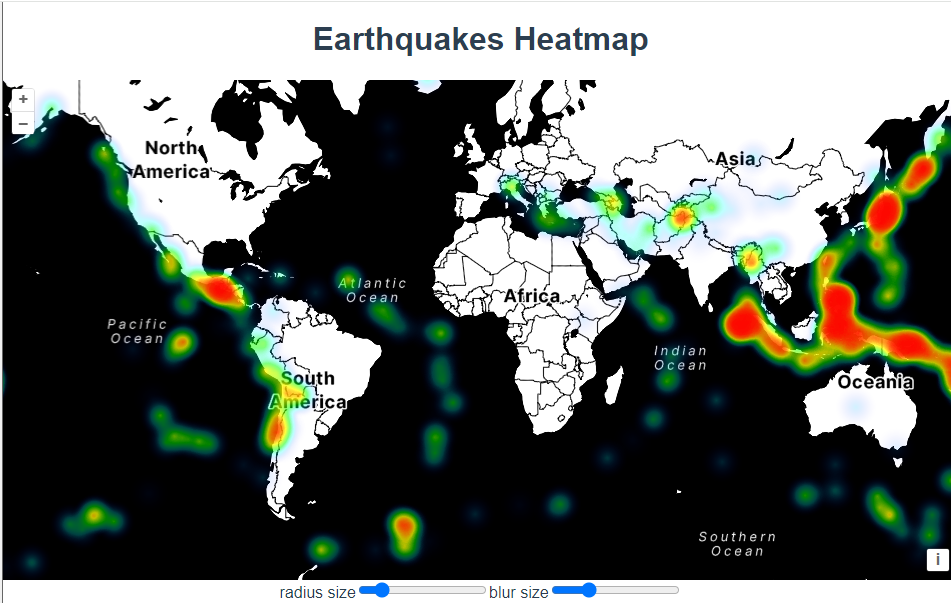
官网demo地址:
这篇主要介绍了热力图HeatmapLayer
HeatmapLayer 是一个用于在地图上显示热力图的图层类型,通常用于表示地理数据中的密度或强度。例如,它可以用来显示地震、人口密度或其他空间数据的热点区域。在这个示例中,HeatmapLayer 被用来显示从 KML 文件中提取的地震数据。
const vector = new HeatmapLayer({
source: new VectorSource({
url: "https://openlayers.org/en/latest/examples/data/kml/2012_Earthquakes_Mag5.kml",
format: new KML({
extractStyles: false,
}),
}),
//热力图的模糊半径,以像素为单位。
blur: parseInt(blur.value, 10),
//每个点的影响半径,以像素为单位。
radius: parseInt(radius.value, 10),
//用于根据特征属性计算热力图中每个点的权重 权重值 应介于 0 到 1 之间
weight: function (feature) {
const name = feature.get("name");
const magnitude = parseFloat(name.substr(2));
console.log("magnitude", magnitude);
return magnitude - 5;
},
});通过滑块的改变控制图层的半径和模糊度
blur.addEventListener("input", function () {
vector.setBlur(parseInt(blur.value, 10));
});
radius.addEventListener("input", function () {
vector.setRadius(parseInt(radius.value, 10));
});完整代码:
<template>
<div class="box">
<h1>Earthquakes Heatmap</h1>
<div id="map"></div>
<form>
<label for="radius">radius size</label>
<input id="radius" type="range" min="1" max="50" step="1" value="5" />
<label for="blur">blur size</label>
<input id="blur" type="range" min="1" max="50" step="1" value="15" />
</form>
</div>
</template>
<script>
import KML from "ol/format/KML.js";
import Map from "ol/Map.js";
import StadiaMaps from "ol/source/StadiaMaps.js";
import VectorSource from "ol/source/Vector.js";
import View from "ol/View.js";
import { Heatmap as HeatmapLayer, Tile as TileLayer } from "ol/layer.js";
export default {
name: "",
components: {},
data() {
return {
map: null,
};
},
computed: {},
created() {},
mounted() {
const blur = document.getElementById("blur");
const radius = document.getElementById("radius");
const vector = new HeatmapLayer({
source: new VectorSource({
url: "https://openlayers.org/en/latest/examples/data/kml/2012_Earthquakes_Mag5.kml",
format: new KML({
extractStyles: false,
}),
}),
//热力图的模糊半径,以像素为单位。
blur: parseInt(blur.value, 10),
//每个点的影响半径,以像素为单位。
radius: parseInt(radius.value, 10),
//用于根据特征属性计算热力图中每个点的权重 权重值 应介于 0 到 1 之间
weight: function (feature) {
const name = feature.get("name");
const magnitude = parseFloat(name.substr(2));
console.log("magnitude", magnitude);
return magnitude-5;
},
});
const raster = new TileLayer({
source: new StadiaMaps({
layer: "stamen_toner",
}),
});
new Map({
layers: [raster, vector],
target: "map",
view: new View({
center: [0, 0],
zoom: 2,
}),
});
blur.addEventListener("input", function () {
vector.setBlur(parseInt(blur.value, 10));
});
radius.addEventListener("input", function () {
vector.setRadius(parseInt(radius.value, 10));
});
},
methods: {},
};
</script>
<style lang="scss" scoped>
#map {
width: 100%;
height: 500px;
}
.box {
height: 100%;
}
</style>






















 4832
4832

 被折叠的 条评论
为什么被折叠?
被折叠的 条评论
为什么被折叠?








